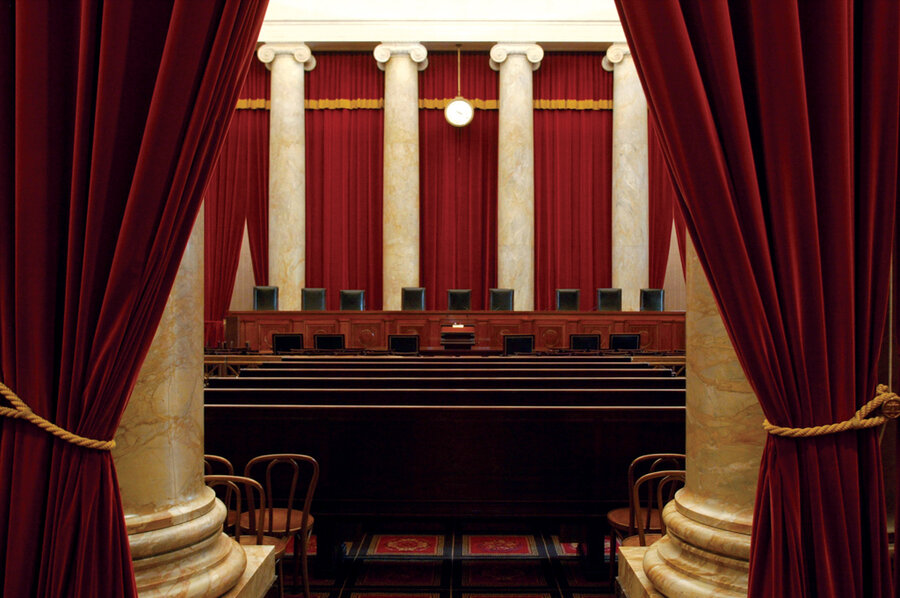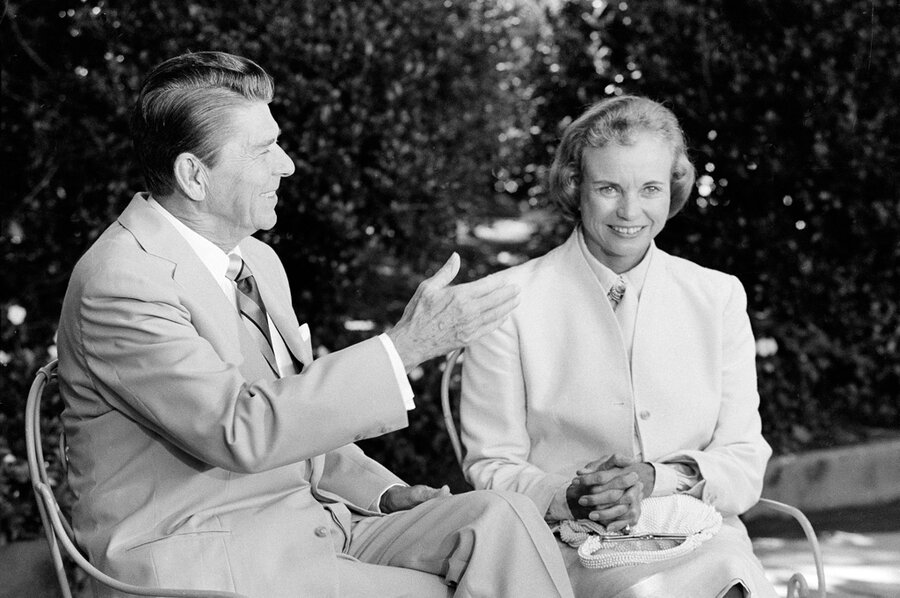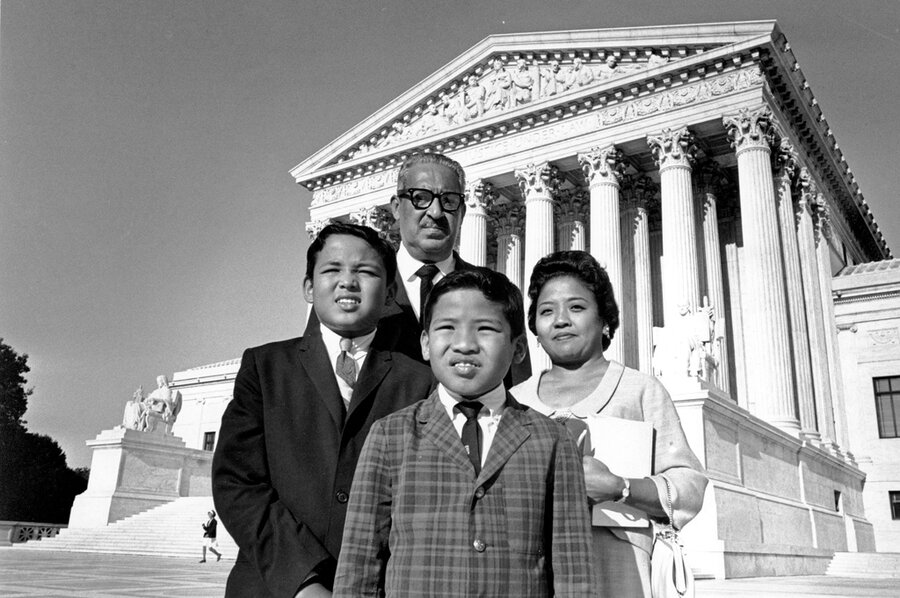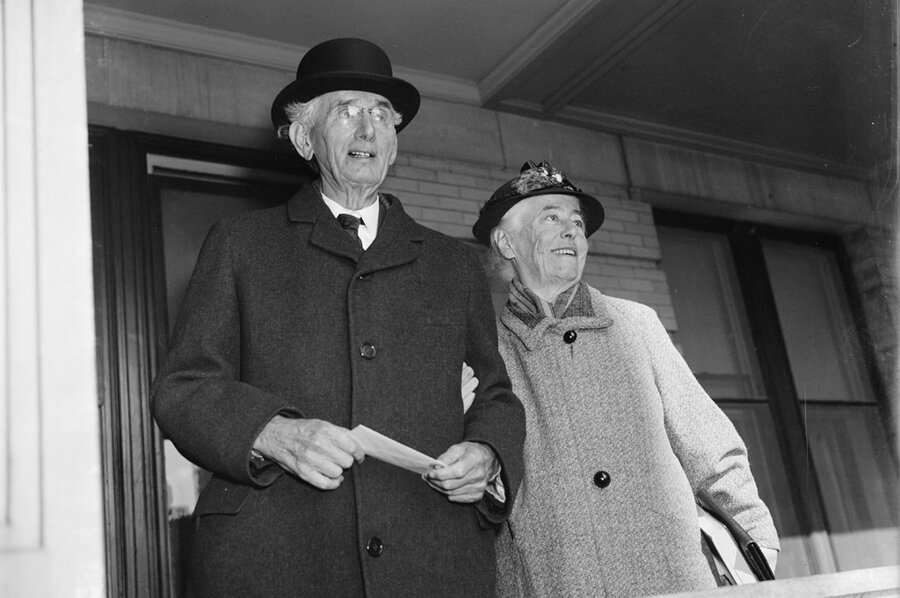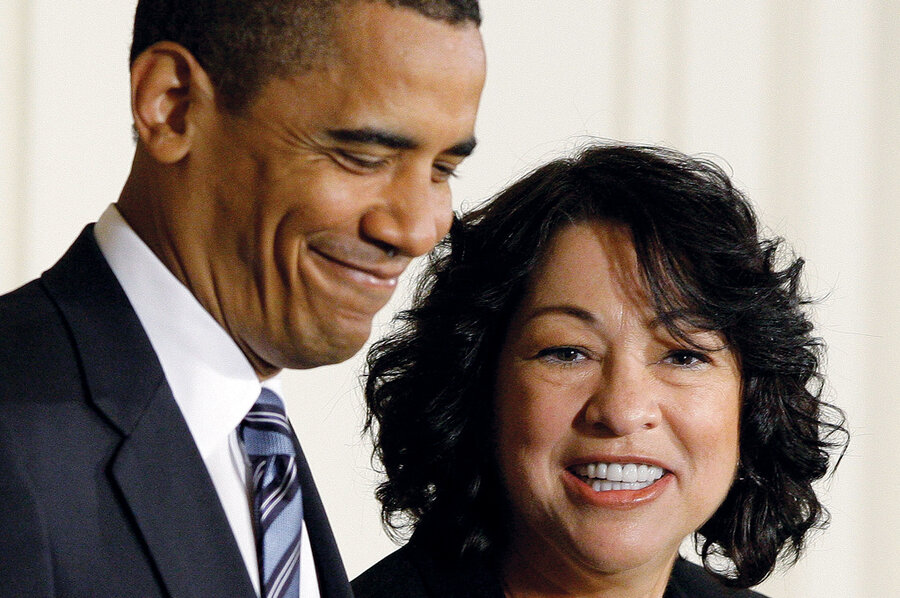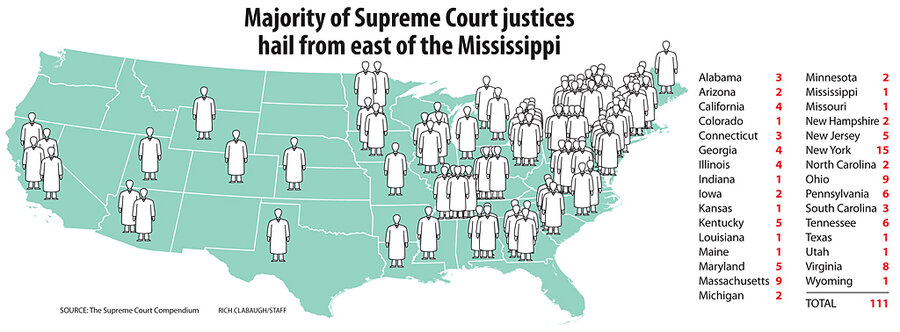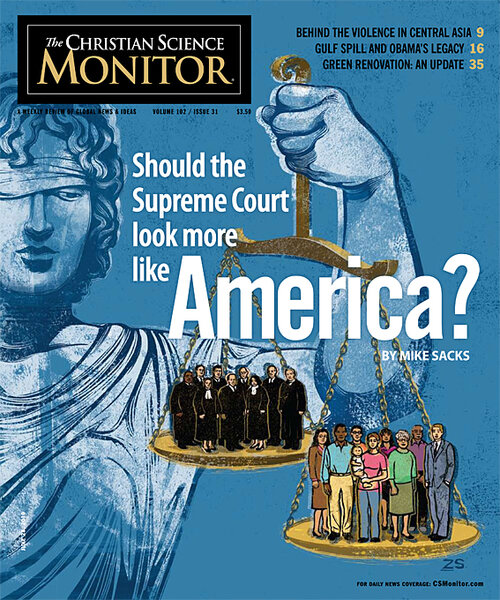Elena Kagan: Would she turn Supreme Court into We the People?
Loading...
| Washington
They are fathers and sons, mothers and daughters, opera lovers and salsa dancers, long-winded pedants and quick-witted conversationalists, cancer survivors and nonagenarian swimmers, West Coasters and East Coasters, Winnebago drivers and airplane pilots. Aside from being nine of the most powerful men and women in the United States, the Supreme Court justices are also a lot like We the People.
But when we talk about the court looking like America, we also mean things such as the justices' religions, races, genders, and sexual orientations. We mark our progress as a society by the diversity of these traits on the court. And President Obama's nomination of Solicitor General Elena Kagan makes plain how far we've come, and for some, how much further we have to go.
If Ms. Kagan is confirmed after US Senate hearings scheduled to start June 28, then the court will have certain demographics represented in numbers that 50 years ago would have seemed unimaginable: three women, three Jews, six Roman Catholics. Kagan's confirmation also would mean that, for the first time, the court would be left without any white Protestant males, who until 1993, commanded a majority of the court.
Yet as commentators, court watchers, and interest groups remind us, a cast of nine characters made up of two religions, three races, one sexual orientation, and an all-Ivy-League pedigree are hardly avatars of the nation's self-image.
But would justice be served any differently if the court looked more like America? As the US political process has grown more pluralistic, that question is complicated by the debate about whether justice can be completely blind and adhere to the letter of the law as if it was unambiguously laid down by the Founding Fathers, or whether modern reality suggests that a justice's background and life experience can fairly factor into a modern interpretation of a 223-year-old Constitution.
• • •
What one looks like is not a proxy for what one believes, warned Justice Thurgood Marshall at his retirement press conference in 1991. Responding to a reporter's question about whether President George H.W. Bush had any obligation to name a minority candidate to succeed Justice Marshall, the nation's first African-American justice said, "My dad told me way back that you can't use race. For example, there's no difference between a white snake and a black snake. They'll both bite."
He meant that race should not be used as an excuse for "doing wrong"; rather it should be a factor to consider in the broader effort to "pick the best person for the job." And, for Marshall, "doing wrong" meant contributing to the increasingly conservative Supreme Court's dismantling of liberal landmarks he'd helped build as a lawyer and justice.
By those definitions, Marshall suggested, Bush's nominee, Clarence Thomas, was "the wrong Negro" to succeed him, where there was a direct line between his experiences as a black man in America to his votes in favor of affirmative action and against the death penalty. Indeed, Justice Thomas's strict originalism – adherence to a literal interpretation of the Constitution – certainly changed the direction of the court's so-called "black" seat.
"The point of the 'black' seat," says Elie Mystal, editor of the popular online legal tabloid Above the Law, "is to recognize and appreciate the fact that there was in this country a people with a historical position of servitude and our commitment to work our way out of that. Thomas goes against those things."
And, echoing Marshall, Mr. Mystal adds: "It's not about black and white; it's about where you stand on civil rights."
Yet to many, Thomas is a political and jurisprudential ideal. In his 19 years on the bench, he has held fast to the "colorblind Constitution," consistently coming to conservative results in cases in which race has played a role. Where Marshall looked favorably upon affirmative action policies, calling them "race-conscious measures designed to remedy past discrimination," Thomas believes they constitute "racial discrimination, plain and simple." And where Marshall cited contemporary studies showing racial imbalance to insist that the death penalty "is in all instances cruel and unusual punishment forbidden by the Eighth Amendment" to the Constitution, Thomas looks to the Founders' generation and their comfort with capital punishment to conclude that "it is clear that the Eighth Amendment does not prohibit the death penalty."
"Thomas approaches the law by trying to look at the history or intent of the Constitution and its framers," says Carrie Severino, policy director of the Judicial Crisis Network, a conservative advocacy group. Thomas's rock-ribbed originalism, then, as opposed to "voting differently based on your identity," Ms. Severino insists, "is the test of whether one is being principled judicially."
Thomas's approach received a public relations boost in the 2005 confirmation hearings for Chief Justice John G. Roberts, when Justice Roberts compared the judges' work to that of umpires – simply calling balls and strikes within the Constitution's preset strike zone. His compelling metaphor – and his flawless performance in those hearings – changed the game for future nominees who might dare to suggest they'd judge any differently.
Under Roberts's rubric, minority candidates would now have to testify that they, like Thomas, would engage in cold constitutional calculus, not Marshall's empathy-inflected jurisprudence.
Accordingly, when Sonia Sotomayor sat before the Senate Judiciary Committee last summer, she appeared positively robotic in agreeing with the Republicans' demands that she disavow any suggestion that her life experience would influence her judging.
Specifically, she sought to obscure the real significance of her oft-delivered line: "I would hope that a wise Latina woman with the richness of her experiences would more often than not reach a better conclusion than a white male who hasn't lived that life."
The "wise Latina" statement clashed with the notion that judges must do nothing more than look to the history or intent behind the law at issue. Justice Sotomayor's Democratic supporters, not at all willing to turn the historic nomination of the first Latin-American to the Supreme Court into a dragged-out national referendum on constitutional interpretation, claimed the quote was taken out of context. But the entire speech, given in 2001, was about "whether by ignoring our differences as women or men of color we do a disservice both to the law and society." She claimed that "aspiration to impartiality is just that – it's an aspiration because it denies the fact that [women and people of color] are by our experiences making different choices than others."
Yet when it came time for Sotomayor to defend her speech, she repeatedly demurred, casting herself as a strict constructionist on the Constitution's text and history.
Unseized upon by either side in the Sotomayor hearings was her comment in the same "wise Latina" speech that "Justice Clarence Thomas represents a part but not the whole of African-American thought on many subjects." Indeed, his personal experience with affirmative action left him feeling as if he'd been stamped with a "badge of inferiority," as he put it in a 1995 opinion. To this day, according to his autobiography, his Yale diploma, upon which he placed a sticker reading "15¢," sits in his basement.
• • •
But diversity as simply an aesthetic versus experience that comes to bear in interpreting the law will not disappear. It affects every potential next "first" on the court – such as the first Asian-American, the first gay, or the first atheist.
But are identity politics antithetical to an independent judiciary?
"The court is not a representative body, and it's not clear its function is to be a representative body in any way," says Barry Friedman, vice dean of the New York University Law School in New York City and author of "The Will of the People: How Public Opinion Has Influenced the Supreme Court and Shaped the Meaning of the Constitution." However, Mr. Friedman concedes, "in deciding legal questions, it does become important for the court's long-term credibility to reach conclusions that are acceptable to the American people."
One way to stay credible is to have justices whom Americans identify with and admire.
"As a minority, it is gratifying and yes, important, for me to see people of color on the Supreme Court and in other positions of leadership," says Viet Dinh, a law professor at Georgetown University in Washington, D.C., and a former high-ranking official in George W. Bush's Department of Justice. "When I see a Justice Thomas or a Justice Sotomayor," continues Mr. Dinh in an e-mail interview, "I am inspired by their example, for the simple reason that they have overcome so much, that they made it there not because of their race, but in spite of it."
Dinh, too, may one day be another's inspiring example. A prominent conservative lawyer who came to the United States in 1978 as a 10-year-old Vietnamese refugee; clerked for Justice Sandra Day O'Connor; and went on to help draft the USA Patriot Act after the terrorist attacks of Sept. 11, 2001; he could very well end up on a Republican president's shortlist for a Supreme Court vacancy.
And if high-profile nominations to the federal courts of appeal are any indication of which demographic is next in line for Supreme Court representation, Asian-Americans appear to be on deck.
Mr. Obama recently nominated Goodwin Liu, whom The New York Times called a "liberal legal rock star," to the San Francisco-based Ninth Circuit Court of Appeals. Professor Liu, a 39-year-old University of California, Berkeley, law professor, has faced the kind of Republican Senate scrutiny reserved for lower-court nominees whose confirmations appear to be little more than steppingstones to the Supreme Court.
In endorsing Liu, the National Asian Pacific American Bar Association (NAPABA) trumpets on its website his many qualifications, then states that the "confirmation of Professor Liu would help promote diversity in the federal judiciary, where Asian Pacific Americans are significantly underrepresented." Such a broad reason for support could as easily apply to Dinh, despite his and Liu's ideological differences.
But while NAPABA has taken no stand on whether diversity's value is aesthetic or experiential, Billy Chan, the Asian-American Bar Association president, has sided with Sotomayor's now-disavowed speech. "[Liu] brings more than his superior qualifications as a lawyer and a teacher. He brings his perspective as a person of color raised and working in the United States," wrote Mr. Chan in an April letter to the editor in the San Francisco Chronicle.
He chided conservatives for assuming "judges can magically remove themselves from life experience and make decisions purely on the facts and the law ... [they] are affected by their background and life experience as well as their intellectual analysis, and it is unrealistic to pretend otherwise."
But upon this sentiment, Dinh, Chan's fellow Asian-American, disagrees. "Justice O'Connor loved saying that a wise old woman thinks the same as a wise old man," says Dinh, voicing the very sentiment Sotomayor contested in her 2001 speech. "I think it is a profound mistake to assume that a person will think a certain way or approach the law from a certain perspective because of their backgrounds, be it race, gender, religion, or even political affiliation."
• • •
In the beginning, long before religion, race, and Roe v. Wade, there was geography. Starting with George Washington's first batch of Supreme Court justices, "the need for geographic diversity was a matter of practicality," says David Yalof, author of the book "Pursuit of Justices: Presidential Politics and the Selection of Supreme Court Nominees." Until Congress created the courts of appeal in 1891, the justices "rode circuit," traveling to their home regions to hear appeals arising out of federal courts.
And geography played a role in President Lincoln's appointment of Justice Stephen J. Field, who came to the court to represent the country's newly admitted Pacific Coast states. His formative experiences in California's unregulated gold rush boomtowns led him to become the architect of the Supreme Court's turn-of-the-century laissez-faire, pro-property rights jurisprudence.
Political loyalty also mattered to the early presidents. Chief Justice John Marshall's Federalist Party affiliation animated perhaps the most important case in Supreme Court history: 1803's Marbury v. Madison. President Adams appointed Marshall in 1801 so as to entrench the Federalists' political philosophy in a national government about to be taken over by their ideological antagonists, Jefferson and his Democratic-Republican Party. By establishing judicial review – or the court's power to strike down an act of Congress – Marshall's Marbury opinion sent a warning to the Jefferson administration and Congressional allies to tread lightly in setting national policy that may be at odds with the Federalists on the court.
Loyalty and geography governed even the nomination of the court's first Catholic, Roger B. Taney. "There is no evidence that [President] Jackson meant to appeal to a Catholic constituency [with Taney]," Mr. Yalof notes.
In the tense antebellum period, presidents sought to maintain the court's sectional balance to stave off the Union's dissolution. When Taney, a slave-holding Marylander, became chief justice in 1836, he represented the sensibilities of the important border state as the court began hearing many cases that divided its justices along regional lines. But Taney's majority opinion in the 1857 Dred Scott case, which found that African slaves and their free descendants could never be US citizens, helped hurl the country toward the Civil War.
Although regional representation continued through and beyond the war, it ceased for a century as political shorthand. Instead, presidents sought political loyalists from every section of the country: Lincoln primarily selected Unionists, Gilded Age presidents largely nominated free marketers, and Franklin D. Roosevelt exclusively seated New Dealers.
"As we get more comfortable with ... 'firsts,' we will begin to fight more along ideological lines and not be hampered by demographic diversity," suggests Guy-Uriel Charles, founding director of the Center on Law, Race and Politics at Duke University in Durham, N.C.
If Professor Charles is correct, then Kagan is the future. She is poised to become the court's third woman and Jew on the current Supreme Court, but one would be hard-pressed to find her jurisprudence questioned or assumed on the basis of her gender or religion. Instead, she has been assailed from the right for her liberal positions in memos to Thurgood Marshall, for whom she clerked in the late 1980s. The left has criticized her for being too deferential to a president's wartime authority in her role as Obama's solicitor general. Further, Kagan will not be expected to speak for all women or Jews, just as Justice John Paul Stevens – whom she has been nominated to replace as he retires – was not expected to speak for all white, Anglo-Saxon Protestant men.
Nevertheless, gender and religion do remain salient in their own distinct ways, argues Charles.
"I think we would all be worried if we had a Supreme Court that was all male," Charles says. A lack of parity could appear to be "discrimination in favor of a particular group rather than the luck of the draw" now that there are so many qualified women for the job.
However, a court evenly split by sex would look suspicious to Severino of the Judicial Crisis Network. With women's "more involved child-caring responsibilities," Severino says, "the kind of person that's going to have spent the amount of time necessary to be in the pretty slim group of people qualified for a Supreme Court nomination is disproportionately going to be male."
Still, she's "happy that we're getting to a place in which Kagan wasn't necessarily chosen because she's a woman," in contrast to how the public perceived President Reagan's 1981 nomination of Justice O'Connor, who came from relative obscurity as a state appeals court judge in Arizona.
As women inch toward parity on the bench, Catholics and Jews are a Senate's vote away from constituting the entire court, reflecting the fact that these religious minorities are part of the American political mainstream. This does not mean, though, that minority religious representation will remain uncontroversial.
"When you have your first Muslim that's appointed to the Supreme Court, it will be a big deal," says Charles, considering the fact that the court and the country continue to be deeply divided on national security issues arising out of 9/11 and the wars in Iraq and Afghanistan. "It will eventually happen, whether in five or 50 years, and it's going to raise some issues for some people, but after it happens, it's going to be less of an issue."
Then there's the question of limited seating. "The court only has nine members, so you can't do an adequate job of representing all of America at once," says David Lat, founding editor of Above the Law and a right-leaning libertarian. As a gay Asian-American, he runs the numbers per his own demographics. Asian-Americans are 5 percent of the population and gays are 10 percent. Both groups currently claim no justices, but will be proportionally overrepresented upon the confirmation of just one.
Kevin Cathcart, the executive director of Lambda Legal, a gay rights advocacy organization, takes a longer view and finds that the court has some catching up to do. "If you look at the justices over the court's history or even in the last 20 years, the number of them that have been women or people of color is staggeringly low."
Nevertheless, says Mr. Cathcart, "the likelihood of getting an openly gay person on the Supreme Court will be much improved when we live in a society in which openly gay people can more reasonably aspire to positions throughout the federal bench."
But rising through the judicial system is hardly the only route to a seat on the court – 39 of the 111 justices over time have not been judges before. By nominating Kagan, Obama may have started a trend back toward tapping nonjudges for the court, which had not been repeated after President Nixon's 1971 nominations of William Rehnquist, a Justice Department lawyer, and Lewis Powell, a prominent corporate attorney in private practice.
But although Cathcart has seen "dramatic increases" in the acceptance of gay people in law firms, academia, and elected office over the past two decades, he believes the confirmation process for openly gay nominees selected from those fields will be a significant obstacle as long as sexual orientation remains politicized in the Senate.
• • •
Gender, race, religion, ethnicity, and sexual orientation are all critical components in the court's most politically charged and bitterly divisive issues, from abortion and affirmative action to national security and gay rights. Even if the results in these cases often seem zero-sum, all sides recognize the symbolic importance of a more diverse bench making the decisions.
But when those decisions ultimately boil down to answering "yes" or "no" on questions of great public interest, explains Friedman, the author of a book on the court and public opinion, "it's not going to be uncommon for people to divide 5-4," whatever their backgrounds.
So the court, staffed by men and women nominated and confirmed for their ideological fealty to one of two political parties, doesn't threaten kaleidoscopic chaos in its judgments.
Rather, the court is more like an ever-improving pair of 3-D glasses. Whether a justice comes to a decision aided by – or in spite of – his or her life experiences, a diverse bench enriches the court, united or divided, and may more clearly see and reflect American attitudes in their most true-to-life details.
It may be a gradual evolution for minority justices who start out as "avatars of their entire communities" to be regarded as fully absorbed additions to age-old ideological factions, says Wajahat Ali, a Pakistani-American lawyer and political commentator. "But America is one of those places, just by virtue of its creation, [where] these things really can occur."
• Matt Rocheleau contributed research.




